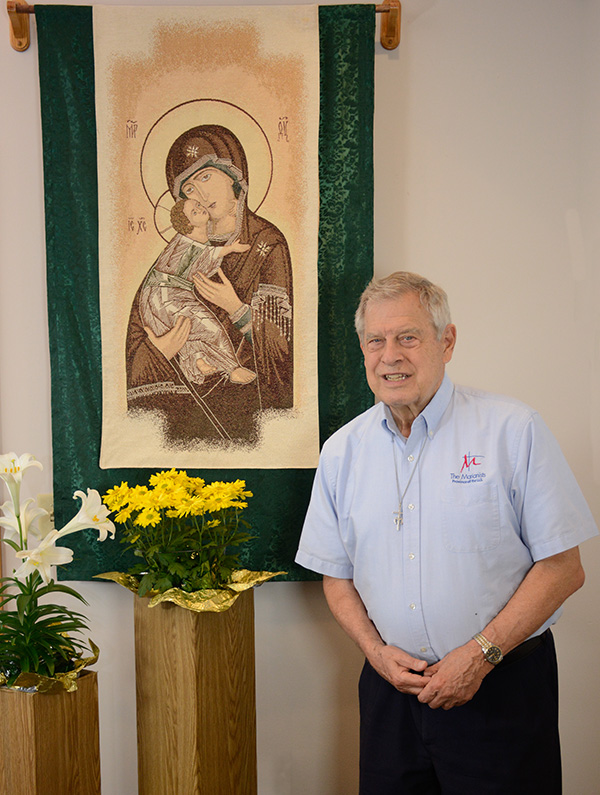Brother Ray leads with a servant's heart
As a teenager searching for his life’s calling, Brother Ray Fitz, S.M. ’64, met Tom Dooley, a doctor who helped evacuate refugees during the Vietnam War and started hospitals in remote parts of Southeast Asia.
“I was beginning to think, ‘What do I want to do with my life?’ He planted the seed that you can use your life to make a difference,” Fitz recalled.
That seed, once planted, took root.
 A football standout at St. Vincent’s High School in Akron where he was known for his grit on the gridiron, Fitz turned down a football scholarship from the University of Detroit and left a hometown girlfriend to enter the novitiate in Marcy, New York. After professing temporary vows, he moved to Mount St. John in Dayton. Along with 40 other men considering Marianist life, he commuted to the University of Dayton, where he earned an electrical engineering degree in 1964.
A football standout at St. Vincent’s High School in Akron where he was known for his grit on the gridiron, Fitz turned down a football scholarship from the University of Detroit and left a hometown girlfriend to enter the novitiate in Marcy, New York. After professing temporary vows, he moved to Mount St. John in Dayton. Along with 40 other men considering Marianist life, he commuted to the University of Dayton, where he earned an electrical engineering degree in 1964.
With a group of Marianists, he helped open Monsignor Hackett Catholic High School in Kalamazoo, Michigan, where he taught math, physics and mechanical drawing. After a year in the classroom, he made his perpetual vows and entered graduate school, earning a master’s degree and doctorate in electrical engineering from the Polytechnic Institute in Brooklyn.
Then he returned to Dayton to begin a remarkable 50-year (and counting) legacy of service to his alma mater, where his impact — as a teacher, the longest-serving president in school history, social justice advocate and Marianist brother — has been unparalleled.
“Brother Ray models what it means to be a servant-leader.” —Eric F. Spina
“Humble and selfless to a fault, Brother Ray models what it means to be a servant-leader,“ said UD President Eric F. Spina.
”His life’s work has been about empowering people to use their gifts to serve others, particularly in our community’s urban core,” continued Spina, who draws on Fitz’s philosophy of service to others in his own civic engagement work and in the development of UD’s vision to be the university for the common good.
As Fitz steps down this summer as the Father William J. Ferree Professor of Social Justice, a position he’s held for 17 years, he is not stepping away from his life’s work of educating students to be servant-leaders and building safe and supportive neighborhoods for children and families. As a professor, he’ll continue to connect Catholic social teaching to social justice issues through his Leadership in Building Communities seminar. As a sought-after, respected community leader, he’ll continue, as he says, to “bring others to the table” to tackle the seemingly intractable issues of poverty, racism and social injustice.
That work started in his early days as an electrical engineering professor, when he used mathematical modeling to study urban and world hunger issues. Later, during his presidency, he co-chaired a child protection task force after several highly publicized deaths in Montgomery County, and he helped launch neighborhood school centers in Dayton’s poorest elementary schools. Today, he’s working with community and church leaders on “two-generation” poverty-reduction strategies and holding listening sessions in West Dayton to determine a greater role for the Catholic church on alleviating racial injustice.
“I’m pretty good at playing the role of convener, someone who can move people along to action,” he said. “What I’ve been able to do is bring the right people together at the right time with the right talents and keep them focused on doing the right thing. I’ve been accused of too much listening, but people can never say they weren’t heard,” he added with a laugh.
Working with the most vulnerable in the Dayton community, he said, opened his eyes and heart — and deepened his faith.
“I have seen firsthand the hopelessness and desperation of children and families who experience extreme poverty,” Fitz said in an eloquent speech at his Golden Jubilee in 2010. “These experiences have been a gift — a painful gift — but a gift that has allowed me to see the face of God in a new way.”
“The essential is the interior.” —Father William Joseph Chaminade
With Mary, the mother of Jesus, as a model, he strives to live a faith-filled life, anchored in prayer. In the philosophy of Blessed William Joseph Chaminade, founder of the Society of Mary, he values the interior life. His favorite Chaminade saying, “The essential is the interior,” has helped him foster a deeper sense of self, often through silent reflection and contemplation.
“You cannot sustain thoughtful work in social justice without a deep prayer life and reflection,” he said. “The encounter with Christ through prayer gives you the heart to do the work.”
Long before his Marianist housemates arrive for the 7 a.m. daily Mass in the chapel in their home on Stonemill Road, he sits quietly, praying and reflecting on the Scriptures. Later, before bed, he said he’ll “pray over the day, asking God’s grace to do better and giving thanks for God’s grace” in his life.
Fitz discovered his vocation early, weaving a life of faith, leadership and, above all else, service.
“I’m thankful for the grace to be able to touch people’s lives.” — Brother Raymond Fitz
“The concept of educating leaders — people who will make a difference — has been the driving force in my life,” he said. “I’m thankful for the grace to be able to touch people’s lives.”